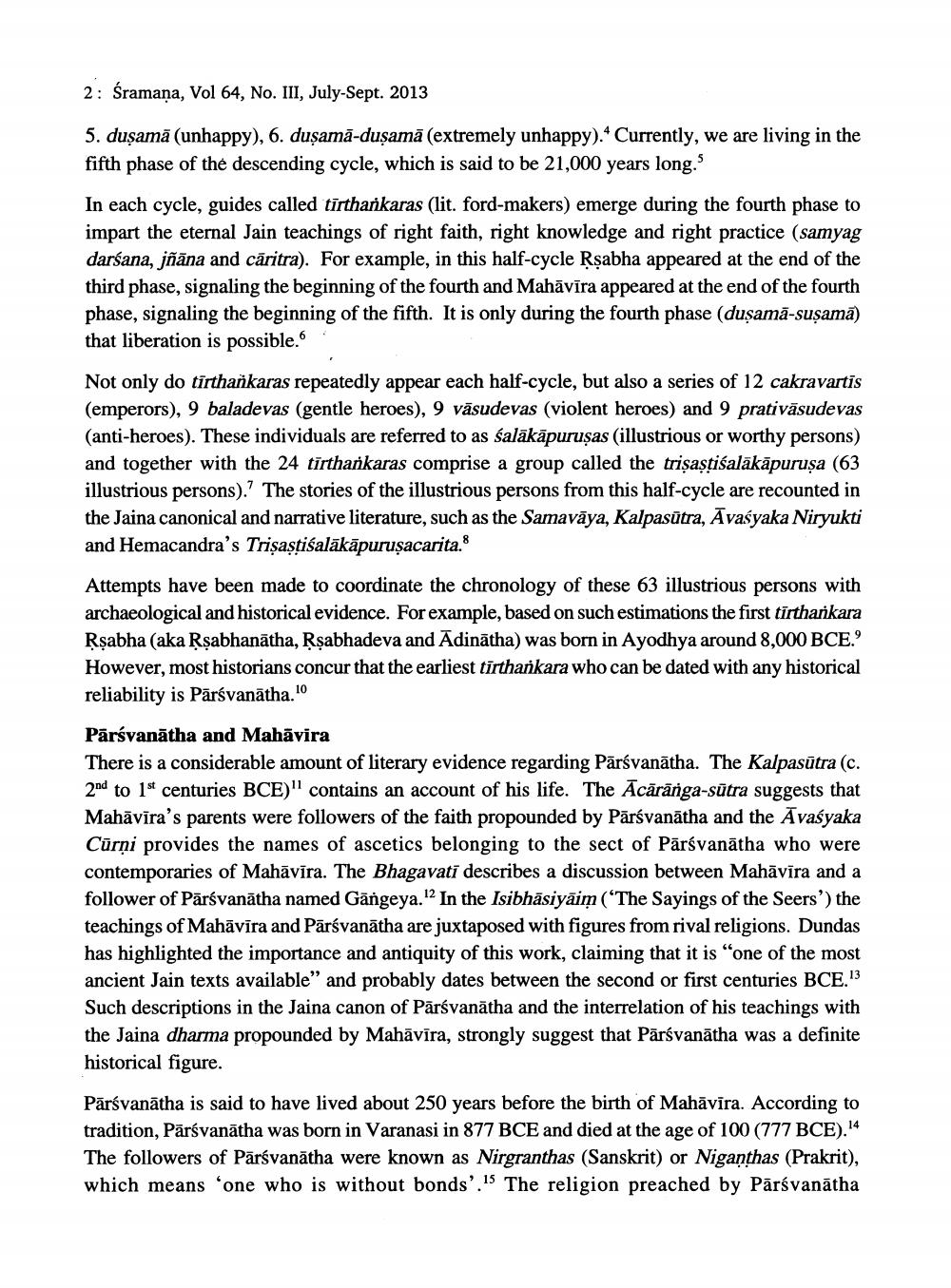________________
2: śramaņa, Vol 64, No. III, July-Sept. 2013
5. dusamā (unhappy), 6. duşamā-duşamā (extremely unhappy). Currently, we are living in the fifth phase of the descending cycle, which is said to be 21,000 years long.
In each cycle, guides called tīrtharkaras (lit. ford-makers) emerge during the fourth phase to impart the eternal Jain teachings of right faith, right knowledge and right practice (samyag darśana, jñāna and cāritra). For example, in this half-cycle Rşabha appeared at the end of the third phase, signaling the beginning of the fourth and Mahāvīra appeared at the end of the fourth phase, signaling the beginning of the fifth. It is only during the fourth phase (duşamā-suşamā) that liberation is possible.
Not only do tīrthařkaras repeatedly appear each half-cycle, but also a series of 12 cakravartis (emperors), 9 baladevas (gentle heroes), 9 vasudevas (violent heroes) and 9 prativāsudevas (anti-heroes). These individuals are referred to as salākāpurusas (illustrious or worthy persons) and together with the 24 tirtharkaras comprise a group called the trişaştisalākāpuruşa (63 illustrious persons). The stories of the illustrious persons from this half-cycle are recounted in the Jaina canonical and narrative literature, such as the Samavāya, Kalpasūtra, Avasyaka Niryukti and Hemacandra's Trisastiśalākāpuruşacarita.
Attempts have been made to coordinate the chronology of these 63 illustrious persons with archaeological and historical evidence. For example, based on such estimations the first tirtharkara Rşabha (aka Rşabhanātha, Rşabhadeva and Ādinātha) was born in Ayodhya around 8,000 BCE. However, most historians concur that the earliest tirthankara who can be dated with any historical reliability is Pārsvanātha. 10
Pārsvanātha and Mahāvira There is a considerable amount of literary evidence regarding Pārsvanātha. The Kalpasūtra (c. 2nd to 1st centuries BCE)" contains an account of his life. The Ācārānga-sūtra suggests that Mahāvīra's parents were followers of the faith propounded by Pārsvanātha and the Avaśyaka Cūrņi provides the names of ascetics belonging to the sect of Pārsvanātha who were contemporaries of Mahāvīra. The Bhagavati describes a discussion between Mahāvīra and a follower of Pārsvanātha named Gāngeya.2 In the Isibhāsiyāim ('The Sayings of the Seers') the teachings of Mahāvīra and Pārsvanātha are juxtaposed with figures from rival religions. Dundas has highlighted the importance and antiquity of this work, claiming that it is one of the most ancient Jain texts available” and probably dates between the second or first centuries BCE.13 Such descriptions in the Jaina canon of Pārsvanātha and the interrelation of his teachings with the Jaina dharma propounded by Mahāvīra, strongly suggest that Pārsvanātha was a definite historical figure.
Pārsvanātha is said to have lived about 250 years before the birth of Mahāvīra. According to tradition, Pārsvanātha was born in Varanasi in 877 BCE and died at the age of 100 (777 BCE).14 The followers of Pārsvanātha were known as Nirgranthas (Sanskrit) or Niganthas (Prakrit), which means 'one who is without bonds'. 15 The religion preached by Pārsvanātha




